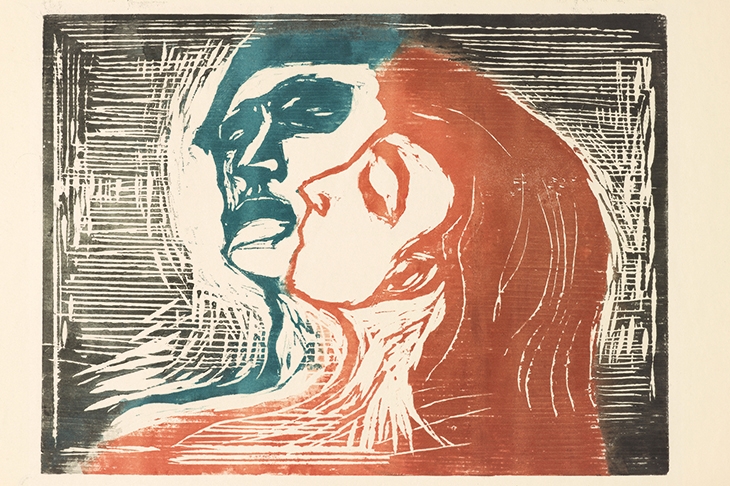An eyewitness described Edvard Munch supervising the print of a colour lithograph in 1896. He stood in front of the stones on which the head of a masterpiece was drawn. He then closed his eyes tightly, stabbed the air with his finger, and gave his instructions. ‘Print… grey, green, blue, brown.’ Then he opened his eyes and remarked, ‘Now it’s time for a glass of schnapps.’ The whole performance, including the air of melodrama and that shot of spirits, was highly characteristic.
The resulting colour lithograph, ‘The Sick Child’, is one of the artist’s masterpieces. It is on show in Edvard Munch: Love and Angst at the British Museum — an exhibition that attempts to do two jobs, and succeeds in doing one better than the other.
As an account of Munch’s life and work, it is — in common with every Munch exhibition I’ve seen — not entirely satisfactory. There are several reasons for this. Munch (1863–1944) was both a long-lived artist and an uneven one. Furthermore, he bequeathed the entire contents of his studio, some 25,000 items, to the city of Oslo. Consequently, if you want to see Munch moderately whole there is no alternative but to travel to Norway and visit the Munch Museum (by which many of the exhibits in the BM show have been loaned).
Munch has often struck me as a case study in how Van Gogh’s life might have played out if he hadn’t shot himself. The Norwegian artist also worked at tremendous pressure in his early days, suffered from recurrent mental problems, complicated by heavy drinking, and one gunshot wound (either inflicted by Munch himself or by an angry woman friend). Love and Angst has difficulty in encapsulating all this.
On the other hand, it succeeds triumphantly in making a virtue out of Munch’s repetitiousness. He was one of those artists who return again and again to certain favourite ideas, sometimes for decades, and reconfiguring them in differing modes and media. ‘The Sick Child’ is a case in point.
This is a depiction of his older sister on her deathbed. The composition was reiterated by Munch, with variations, in no fewer than six paintings and several different types of print over 40-odd years. A selection of these are on view, among them one of the great colour lithographs mentioned above and the Tate’s oil painting from 1907. The juxtaposition of these two works prompts the question: was Munch really at his best as a maker of prints?
To my eye at least the lithographic ‘Sick Child’ outclasses the painted one, superb though the latter is. The print is more concentrated, more epigrammatic and simultaneously more subtle. Munch’s power as an artist, as David Hockney has pointed out, lies in concision. He could do more with less. Often, when you trace the changes through the multiple versions of certain motifs, he seems to be boiling things down.
Some print-making techniques positively encouraged him to do so. Woodcuts, created with a chisel from a bit of timber, just have to be simple and stark. Munch revelled in that roughness. ‘The Kiss IV’ (1900) uses the natural grain of the block to create a setting for the two embracing figures that looks like a forest or a storm.
For similar reasons ‘Self Portrait with Skeleton Arm’, a lithograph from 1896 that greets you as you enter the exhibition, is stronger than painted images of himself from the same period. In the print, Munch stares out from a solid rectangle of darkness — a magnificently dense black — with the clarity and punch of a Warhol.
Some artists aren’t interested in making prints at all; others, having found a medium that suits them, stick to it. Munch, in contrast, wanted to try everything — etching, dry-point, mezzotint — although on this evidence he succeeded best with woodcuts and lithographs. Often he introduced colour into his prints, making them more like paintings in one way, while at the same time bolder and more powerful. Munch also experimented, making up fresh combinations of media. ‘Vampire II’ is a blend of lithograph — the central pair of lovers — and woodcut.
He was evidently interested in everything to do with himself, resenting the sale of his paintings which he regarded as his ‘children’, and as a result the Munch Museum has many of his original lithographic stones, some of which are on show with his original drawing beautifully preserved.
All of this is absorbing and instructive — a lesson in print-making. Despite the distracting sound of an actor reading the artist’s words spilling out of a couple of audio-visual booths, Love and Angst is well worth a visit.






Comments